#GoExploreGreece
Explore tagged Tumblr posts
Text
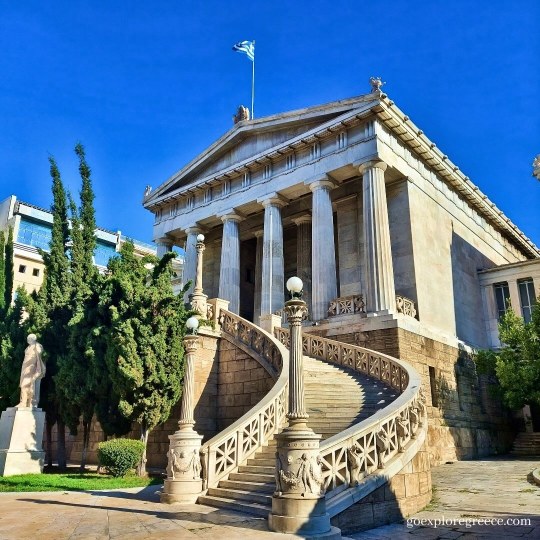
Step inside the grand halls of the National Library of Athens (Vallianeio Megaron) on Panepistimiou Street and discover a treasure trove of knowledge and history. This stunning building, built in the 19th century, used to be home to millions of books, manuscripts, and historical documents that span centuries of Greek culture and civilization.
As soon as you enter the building, you will be greeted by the grand marble staircase that leads to the main reading room. The high ceilings, ornate details, and natural light make it the perfect spot to sit and study or simply take in the beauty of the space. The main reading room is also home to a stunning fresco depicting the nine muses, the goddesses of the arts and sciences in ancient Greece.
But the National Library of Athens is not just a feast for the eyes. It still holds an incredible collection of books and manuscripts. The library's collection is a testament to the country's rich cultural heritage from ancient Greek texts to modern literature. It also houses a vast collection of maps, photographs, and other historical documents, making it a valuable resource for researchers and history enthusiasts.
#greece#goexploregreece#travel#mustsee#mustvisit#greek#europe#athens#athens city#public libraries#library#history#my photos
96 notes
·
View notes
Text
Let's talk about Thessaloniki: Greece's second-largest city. Trust me, you'll want to add this vibrant place to your bucket list.

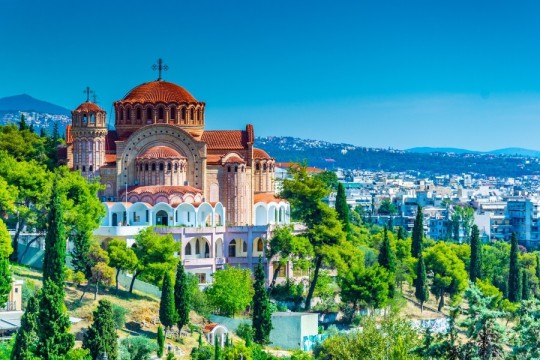

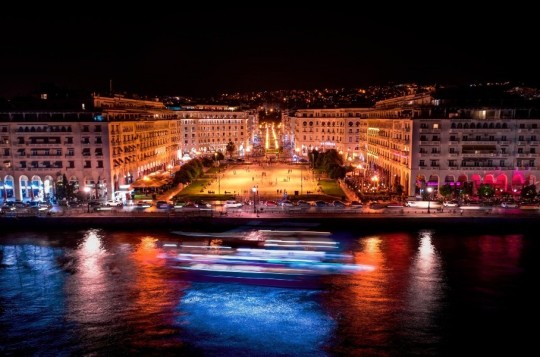
As soon as I arrived, I was blown away by the rich history and culture that surrounds you in Thessaloniki. Walking through the city streets, you'll encounter Roman, Byzantine, and Ottoman influences everywhere you look. The White Tower, Thessaloniki's iconic waterfront landmark, is an absolute must-see.
But it's not just about the history - Thessaloniki is a city that embraces the present, with an exciting contemporary art scene and incredible street art at every turn. Take the chance to visit the State Museum of Contemporary Art and the Thessaloniki Street Art Festival.
Foodies, rejoice! Thessaloniki is a true culinary paradise, combining traditional Greek dishes and modern Mediterranean flavours. I've fallen in love with the local meze culture - a delightful way of sharing small plates of delicious food with friends. The bustling Modiano Market is the perfect place to sample fresh local produce and taste Thessaloniki's gastronomic offerings.
If you're a fan of nightlife, this city will not disappoint. Thessaloniki's buzzing bars and clubs cater to all tastes, from chilled-out jazz bars to high-energy dance clubs. Be sure to check out the famous Valaoritou and Ladadika districts for a night out you will remember.
Nature lovers, don't worry - there's something for you too. Thessaloniki boasts gorgeous seaside promenades and lush green spaces, perfect for a leisurely stroll or a refreshing run. Plus, the nearby Halkidiki Peninsula offers some of Greece's most beautiful beaches and stunning natural scenery.
In short, Thessaloniki has something for everyone, making it the perfect destination for your next adventure. So, what are you waiting for? Start planning your trip to this incredible city today.
#goexploregreece#greecestagram#greecetravel#greece🇬🇷#greece travel#greece#mustvisit#must visit#must see#travel tips#traveling#traveller#travelling#travel#thursday#photooftheday#thessaloniki#halkidiki#citybreak#city#cities
30 notes
·
View notes
Text
Drone Flyover the Acropolis in Athens
For those of you who can't make it to see the Acropolis and Parthenon, want to bring back a few precious memories, or even fancy a short break in your day. Enjoy Ian
youtube
#greece#goexploregreece#travel#mustsee#mustvisit#europe#greek#beautiful views#athens#travel guide#traveling#travelling#dronephotography#dronelife#good vibes#good morning#Youtube
3 notes
·
View notes
Text
I found a rather 'secret' walk along the top of the walls around the Grand Master Palace in Rhodes Old Town. The entrance is only open for 15 minutes each day, and it's just 3 Euro.
youtube
#greece#goexploregreece#travel#mustsee#mustvisit#europe#greek#holiday#rhodes#walkingtours#walkwithme#thingstodo#didyouknow#travel guide#traveller#traveling#Youtube
2 notes
·
View notes
Text

The Holy Church of Saint George ️on the Greek island of Corfu.
#goexploregreece#greece#travel#mustsee#mustvisit#greek#europe#beautiful views#corfuisland#corfugreece#corfu#greekislands#greek islands#church#churches#goodmorning#friday#travelling
44 notes
·
View notes
Text
Let me convince you that the Greek island of Paros is THE place to be.
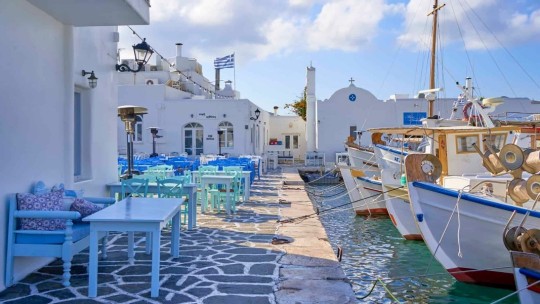
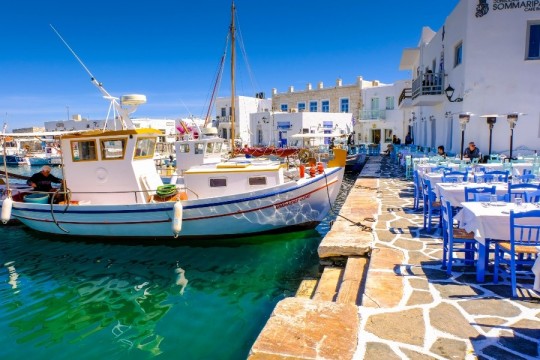
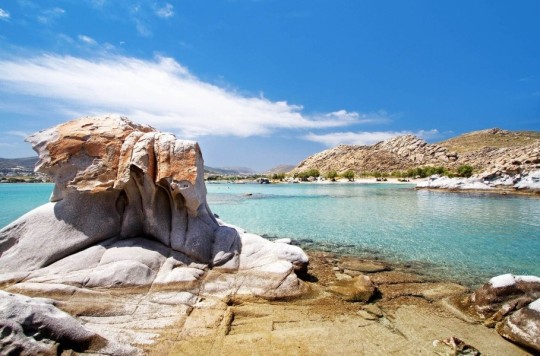
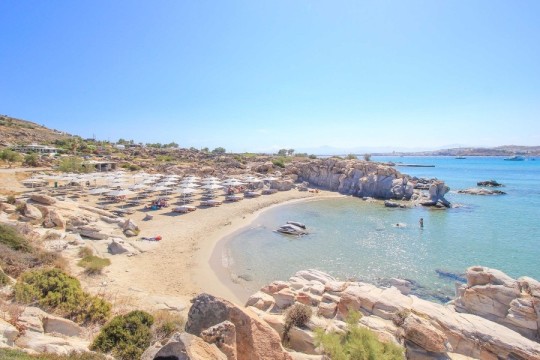
Here are my top 5 reasons to pack your bags and head there for your next holiday.
1. Get lost in the charming village of Naoussa, the picturesque fishing village in the north of Paros. Strolling through its narrow, cobbled streets and admiring the white-washed houses with blue doors and windows will make you feel like you're living in a postcard. The village is also home to a beautiful Venetian castle and a bustling marina.
2. Embrace the vibrant nightlife in Parikia. If you're in the mood for a night to remember, look at the island's capital, Parikia. This lively town is brimming with bars, clubs, and tavernas, offering a fantastic mix of traditional and modern. So, put on your dancing shoes and get ready to party the night away with the locals.
3. Explore the ancient history at the Panagia Ekatontapiliani Church. Built in the 4th century, the Panagia Ekatontapiliani (also known as the Church of 100 Doors) is a must-visit for history buffs.
4. Soak up the sun at the golden beaches of Paros. What's a Greek island holiday without some beach time, right? Paros boasts an array of stunning beaches, each with its own unique charm. Whether you're looking for a secluded spot to unwind or a lively beach with water sports, you'll find it here. My favourites are Kolymbithres Beach, with its otherworldly rock formations, and the windsurfer's paradise of Golden Beach.
5. Sail away on a boat trip to nearby islands. No trip to Paros would be complete without exploring the surrounding islands. Hop on a boat tour and discover the breathtaking beauty of nearby Antiparos, Naxos, and the uninhabited islets of the Small Cyclades. The crystal-clear waters, stunning landscapes, and secluded beaches will leave you speechless.
#goexploregreece#greece#travel#mustsee#mustvisit#europe#holiday#travel tips#traveling#travel photography#wanderlust#places to visit#trip#beautiful views#must visit#must see#paros#cyclades#greek island#greek islands#islands#island hopping#visit greece
22 notes
·
View notes
Text
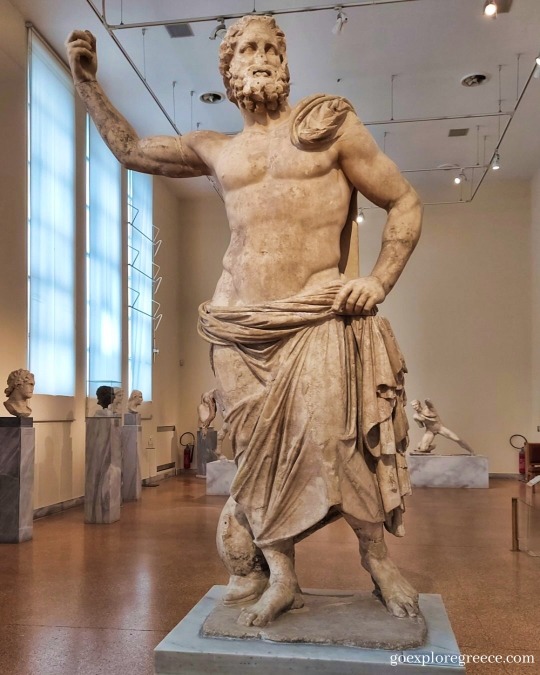
The power of Poseidon lives on through the centuries in the awe-inspiring Poseidon of Melos statue.
Located at the National Archeological Museum in Athens, the Poseidon of Melos statue is one of the most captivating ancient artworks in the world, and has a rich and fascinating history.
With its magnificent form and lifelike details, the Poseidon of Melos statue is a true work of art. Discovered on the Greek island of Melos in 1877, the statue depicts the god Poseidon in all his power and majesty. The god is shown standing tall and proud, his muscular body and regal features capturing the essence of power and strength. From the intricate detailing of his hair and beard to the intricate folds of his robes, the statue is a masterful example of ancient Greek artistry.
But the story of the Poseidon of Melos statue is just as intriguing as its appearance. It was originally discovered on the island of Melos, which was once home to one of the most thriving ancient civilisations in the Greek world. The statue was believed to have been created around 100 BC and likely symbolised the island's wealth and prosperity.
#greece#goexploregreece#travel#mustsee#mustvisit#greek#europe#athens#statues#museumlife#museums#museum#poseidón#greece🇬🇷#traveling#travel tips
36 notes
·
View notes
Text
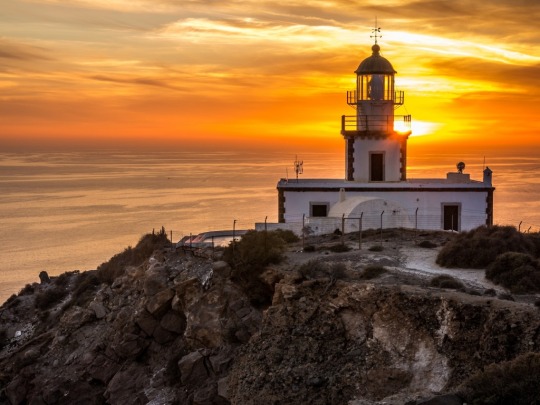
Sunset at Akrotiri Lighthouse. Pure magic.
Today, I want to take you on a journey to the stunning Akrotiri Lighthouse on the Greek island of Santorini.
You may have heard it referred to as the Faros Lighthouse, but don't worry, it's the same place. Faros (Φάρος) is the Greek word for a lighthouse.
Akrotiri Lighthouse is located on the southernmost tip of Santorini, in a town called Akrotiri (surprise, surprise). It was built in 1892, and since then, it has guided sailors safely through the treacherous waters of the Aegean Sea.
Now, you may be wondering why a lighthouse was necessary in the first place. Well, back in the day (and by "the day", I mean the late 1800s), ships relied on the stars to navigate the sea. But when the skies were cloudy or stormy, it made it nearly impossible for sailors to find their way. That's where lighthouses came in. They were built to guide ships with a bright, shining light that could be seen from miles away.
The construction of Akrotiri Lighthouse took two years and was finally completed in 1892. At the time, it was a state-of-the-art lighthouse with a rotating lens that could project light up to 22 nautical miles away.
Over the years, Akrotiri Lighthouse has seen its fair share of history. During World War II, the Germans occupied Santorini and used the lighthouse as an observation point. And in 1956, a massive earthquake struck the island and damaged the lighthouse so severely that it had to be rebuilt entirely.
But despite this, Akrotiri Lighthouse still stands tall today, guiding ships safely through the Aegean Sea. And let me tell you, it is absolutely worth a visit.
The lighthouse is a beautiful, white structure perched atop a sea cliff. You can see the crystal-clear waters and the surrounding cliffs and islands from there. It's truly a breathtaking sight.
But here's a pro tip: if you want the ultimate experience, visit the lighthouse at sunset. The view of the sun setting over the sea is magical. And as the sun dips below the horizon, the lighthouse's light begins to shine, creating a stunning contrast between light and dark.
#goexploregreece#greece#travel#goexplore#mustsee#mustvisit#greek#europe#beautiful views#santorinigreece#santorini#greek islands#lighthouse#thursday#incredible views#sunsets
28 notes
·
View notes
Text
Have you ever heard of the Vlacherna Monastery on the Greek island of Corfu?
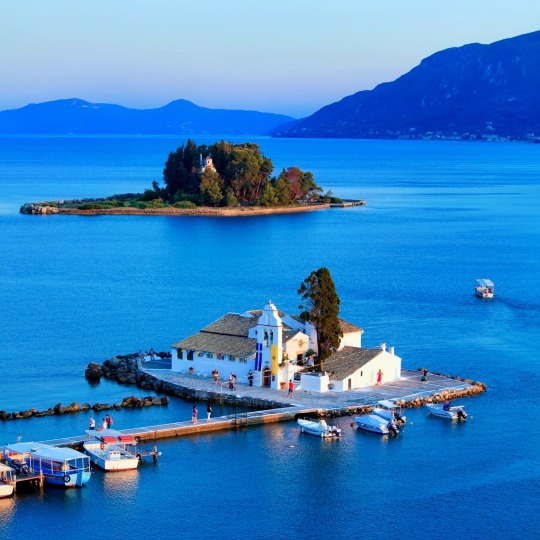
It is located on its own island off the coast of Kanoni, just a few kilometres south of Corfu Town.
It was built during the 17th century and is one of the most iconic landmarks of Corfu. The Monastery is actually a small church dedicated to the Virgin Mary, connected to the mainland by a small bridge, and surrounded by beautiful gardens.
Now, let me share three interesting facts about the Vlacherna Monastery that you might not know:
1. The Monastery is not only a religious site but also a cultural one. It has been featured in many movies, TV shows, and documentaries, including the James Bond film "For Your Eyes Only".
2. The small island where the Monastery is located was once a popular spot for fishermen to sell their catch of the day. Today, you can still see some fishermen selling their fresh catch from the small pier near the Monastery.
3. The Monastery is also home to a small museum, where you can learn more about the history of the Monastery and the island.
If you're planning a trip to Corfu, I highly recommend visiting the Vlacherna Monastery. It's a peaceful and serene place with breathtaking views of the sea.
Don't forget to take a stroll around the Monastery and enjoy the beauty of the gardens. And if you're feeling adventurous, you can even take a boat tour around the nearby Mouse Island, another beautiful landmark of Corfu.
#goexploregreece#greece#travel#mustsee#mustvisit#greek#europe#beautiful views#corfuisland#corfugreece#corfu#churches#church#monastery#monastaries#monday#good morning#mustvisitplace#greek islands#travelling
21 notes
·
View notes
Text
Step into the enchanting world of Mamma Mia (2008) as I reveal the nine scenes with their respective filming locations across Greece.
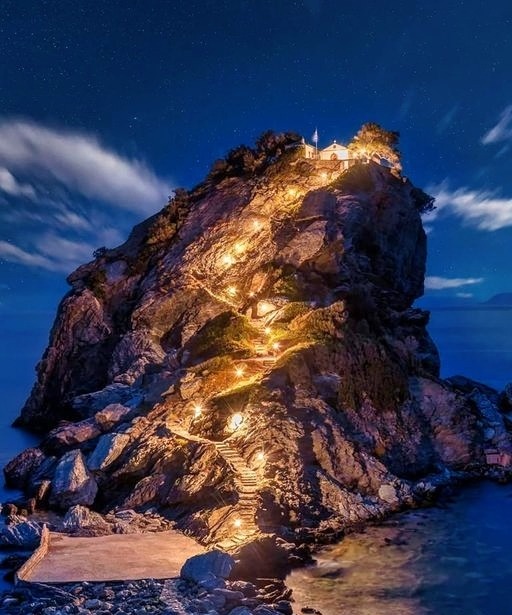
Get ready to be captivated by the charm and allure of these unforgettable spots, and let them inspire your next adventure:
1. Scene: Sophie and her friends walking through the village, singing "Honey, Honey." Location: Damouchari, Pelion, a small village with picturesque alleys.
2. Scene: Sophie mails the wedding invitations. Location: The Old Port in Skiathos Town, Skiathos.
3. Scene: Sky and Sophie sing "Lay All Your Love on Me" at the pier. Location: Amarantos rocks, Agnontas, Skopelos, featuring the rocky coastline and clear waters.
4. Scene: The musical number "Dancing Queen" and Sophie's bachelorette party. Location: Kastani Beach, Skopelos.
5. Scene: Donna and Sam sing "The Winner Takes It All." Location: The Church of Agios Ioannis Kastri, Skopelos.
6. Scene: Tanya performs "Does Your Mother Know." Location: Glisteri Beach, Skopelos, featuring a beautiful pebble beach and tranquil atmosphere.
7. Scene: Harry sings "Our Last Summer" with Donna and Tanya. Location: Glossa Village, Skopelos, highlighting the traditional architecture and narrow streets.
8. Scene: Bill and Rosie sing "Take a Chance on Me." Location: Agnontas Harbor, Skopelos, showcasing the scenic bay and waterfront.
9. Scene: The wedding ceremony and reception. Location: Church of Agios Ioannis in Kastri, Skopelos. This picturesque church is perched atop a rocky hill and offers stunning views of the surrounding area and the Aegean Sea.
#greece#goexploregreece#travel#mustsee#mustvisit#greek#europe#beautiful views#exploregreece#exploremore#greecetravel#skiathos#abba#travelinspiration#inspiration#film#filmlocation#mamma mia#mama mia#wheretonext#visitgreece
14 notes
·
View notes
Text
Athens Walking Tour: We begin at the Metropolitan Cathedral of Athens and end at the Arch of Hadrian. In between, we meander through the Plaka neighbourhood and Monastiraki Square and see Ancient Sites, including the Tower of the Winds. So, go look for your best toga, tie up your sandals, and let's GoExploreGreece.
#goexploregreece#greece#travel#mustsee#mustvisit#europe#beautiful views#athens#holiday#walkwithme#walking tour#walking#athens city#travel guide#travelling#traveltips#youtube video
4 notes
·
View notes
Text
Athens Walking Tour: Evening Walk Monastiraki, Ermou Street, Syntagma
Join me on an evening walk around Athens. Begining in my favourite neighbourhood Thissio, into Monastiraki Square, along Ermou Street and then finishing at Syntagma Square.
It's full of travel tips, and I'll show, point out, and explain many things, such as the best bars, cafes, and restaurants, including the two best places to eat Souvlaki. The best Ancient Sites to visit. How about a 950-year-old shopping mall you can still walk around today, and a 1000-year-old church slap bang in the middle of the busiest shopping street in Athens, and lots more.
So, go look for your best toga, tie up your sandals and let's Go Explore Greece.
#goexploregreece#greece#travel#mustsee#mustvisit#europe#beautiful views#athens#walking tour#traveltips#traveltipsandtricks#walkwithme#evening walk#exploremore
2 notes
·
View notes
Text
Lindos Acropolis, where history and mythology come to life.

I want to share with you all about one of the most breathtaking places I've ever been to - Lindos Acropolis on the Greek island of Lindos in the Dodecanese.
Perched atop a hill overlooking the Aegean Sea, the Lindos Acropolis is an ancient citadel that dates back to the 4th century BC. It's a place steeped in history and mythology, and walking through its ruins, you can't help but feel a sense of awe and wonder.
According to legend, the Acropolis was once the home of the mythological Lindian Athena, who was said to have protected the city from enemy invasions.
As you make your way up the hill to the Acropolis, you'll be greeted by the stunning Doric temple dedicated to Athena Lindia, considered one of the best-preserved temples in Greece. The temple dates back to the 3rd century BC. It is a testament to the skill and artistry of the ancient Greek architects and sculptors.
Once you reach the top of the hill, you'll be treated to panoramic views of the Aegean Sea and the surrounding countryside. The Lindos Acropolis is surrounded by a fortified wall, which gives you a sense of how important this site was to the ancient Lindians. The ruins of the ancient houses and buildings are scattered throughout the area, providing a glimpse into what life was like in this ancient city.
It's a place that will leave you in awe of the beauty and history of Greece. And remember to bring your camera, because the views are truly breathtaking.
#goexploregreece#greece#travel#mustsee#mustvisit#greek#dodecanese#rhodes#acropolis#lindos acropolis#lindos#greek islands#good morning#thursday#traveller#travel tips
18 notes
·
View notes
Text

So, Kalo Mina (Καλό μήνα) – it literally means "Good Month" in Greek. It's a delightful way the Greeks wish each other well at the start of every month. It's as if they're sprinkling a bit of good-luck fairy dust for the month ahead.
It's not just a casual greeting, mind you. There's a hearty warmth to it, like a cosy blanket on a nippy British evening. The idea is to spread positivity and hope – something we could all do with a bit more of, right? It's like saying, "Here's to a cracking month ahead!" but with that enchanting Mediterranean zest.
I find it quite a refreshing change from the usual "Hi, how are you?" drill. It's a bit like how we Brits obsess over the weather, but instead of grumbling about the rain, Greeks are busy sending good vibes for the month. It's wonderfully optimistic, don't you think?
So, here's me saying "Kalo Mina" to you. May your month be as splendid as a perfectly brewed cup of Greek coffee.
4 notes
·
View notes
Text
Tilos: Where peace meets nature.

The charming island of Tilos, also known as the "Island of Peace and Nature," Tilos is a dream destination for those who want to unwind and experience authentic Greek island life.
Tilos is nestled in the Dodecanese between the larger islands of Rhodes and Kos and boasts an area of about 64 square kilometres. Unlike its bustling neighbours, Tilos is an oasis of tranquillity that has managed to preserve its natural beauty and charm.
Getting to Tilos is a breeze. You can hop on a ferry from Rhodes or Kos, with regular connections available throughout the summer. For a more convenient option, book a flight to Rhodes and then catch a ferry to Tilos.
Now, let's talk about what makes Tilos so unique. The island is renowned for its lush flora and fauna, which can be attributed to its status as an eco-friendly destination. In fact, Tilos was the first Mediterranean island to become energy self-sufficient through renewable sources. How cool is that?
Tilos is a proud producer of honey, almonds, and olives, all of which you can find at local shops and restaurants. Don't miss the chance to sample these delicacies and take some home as gifts for friends and family.
Ready to explore? Here are my top three choices for things to do on Tilos:
1. Visit the Monastery of St. Panteleimon: Perched atop a hill with stunning island views, this 15th-century monastery is a must-see. Explore its beautiful architecture and take in the tranquillity that surrounds it. 2. Hike to Mikro Horio: Nature lovers, this one's for you! Hike to the abandoned village of Mikro Horio and discover its history while enjoying the beautiful scenery. Don't forget your camera. 3. Relax at Eristos Beach: Unwind on the golden sands of Eristos Beach and take a refreshing dip in the crystal-clear waters. Perfect for a lazy day in the sun.
#goexploregreece#explore#exploregreece#exploremore#exploretheworld#goexplore#greece#greecelover#greecstagram#greecetravel#greekisland#greekislands#holiday#mustsee#mustvisit#tips#traveltips#travel#traveladdict#visitgreece#wheretonext#dodecanese#tilos
14 notes
·
View notes
Text
Today, I'm going to share some fascinating insights into one of the most iconic flags in the world – the Greek national flag. So grab an ouzo and let's dive into its colourful history.
You might know it as the "blue and white", but did you know the Greek flag is also referred to as the "Γαλανόλευκη" or "Galanolefki" in Greek? It means "blue and white".
The flag consists of nine horizontal stripes alternating between blue and white. The top and bottom stripes are blue, while the white cross on the upper left corner symbolises Eastern Orthodox Christianity, the established religion of the Greeks. Why nine, you ask? Well, it's believed to represent the nine syllables of the Greek phrase "Ελευθερία ή Θάνατος" ("Eleftheria i Thanatos"), which translates to "Freedom or Death" – the famous rallying cry of the Greek War of Independence (1821-1830) against the Ottoman Empire.
As for the colours, blue and white? The blue represents the sky and the sea – two elements deeply intertwined with Greece's identity. The white signifies the purity of the Greek struggle for freedom and independence. Quite poetic, isn't it?
Now, let's jump into a bit of history. Although the modern flag we know today was officially adopted on 22 December 1978, its roots can be traced back to the Byzantine Empire (330-1453 AD). The Byzantine flag featured the double-headed eagle and the imperial colours – yellow and purple. After the fall of the Byzantine Empire, these colours fell out of use, and blue and white emerged as symbols of the Greek nation.
During the Greek War of Independence, different variations of the flag were used by Greek forces. One of the most famous examples is the flag raised by Andreas Londos, a leader in the Greek Revolution, featuring a white cross on a blue background. Another flag, raised by Nikitaras, another revolutionary leader, had the blue cross on a white background.
#goexploregreece#goexplore#exploremore#exploregreece#exploretheworld#explore#tradition#world flags#greek flag#travel tips#traveling#traveller#travelling#travel#greecestagram#greecetravel#celebration#inspiration
13 notes
·
View notes